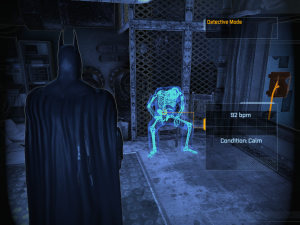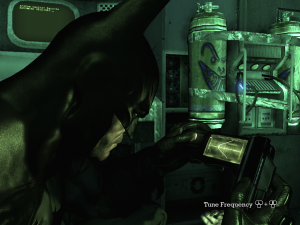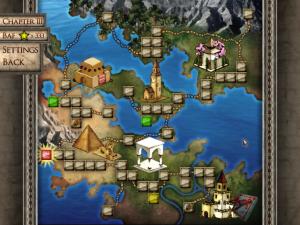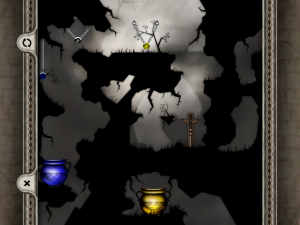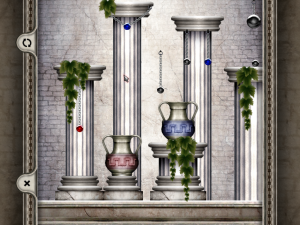VVVVVV
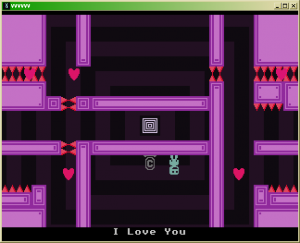 And so we’re finally caught up to the present. Terry Cavanaugh’s VVVVVV was released in January of this year, and I immediately knew that it had to be the final game in my chronological run-down. Its Commodore-64-like pixel art and chiptune soundtrack are a good way to come full circle and bring us back to the beginnings of the exercise, and at the same time perfectly representative of modern trends. For this is very much a modern game in its design sensibility. It uses retroisms to set a mood (and arguably uses them better than the genuinely old titles it imitates, which fought against their limitations instead of using them as strengths), but it’s full of practices that only became commonplace long after the Jet Set Willy era: infinite lives, optional collectibles (here wryly identified as “shiny trinkets”), nonlinearity without artificial gating. Relating to that last point, it even features a newish development that isn’t common yet — apparently a couple of other significant titles have experimented with it — but which I suspect will be, at least in indie titles: optional unlocking. Achieving certain things in the game unlocks stuff like special challenge modes or the ability to play different background music in your main base, but you can also just unlock stuff from the main menu. You don’t even need a cheat code; the philosophy is that if you like unlocking stuff through gameplay (which a lot of people clearly do), you can do that, but if you don’t, it’s not going to withhold content from you.
And so we’re finally caught up to the present. Terry Cavanaugh’s VVVVVV was released in January of this year, and I immediately knew that it had to be the final game in my chronological run-down. Its Commodore-64-like pixel art and chiptune soundtrack are a good way to come full circle and bring us back to the beginnings of the exercise, and at the same time perfectly representative of modern trends. For this is very much a modern game in its design sensibility. It uses retroisms to set a mood (and arguably uses them better than the genuinely old titles it imitates, which fought against their limitations instead of using them as strengths), but it’s full of practices that only became commonplace long after the Jet Set Willy era: infinite lives, optional collectibles (here wryly identified as “shiny trinkets”), nonlinearity without artificial gating. Relating to that last point, it even features a newish development that isn’t common yet — apparently a couple of other significant titles have experimented with it — but which I suspect will be, at least in indie titles: optional unlocking. Achieving certain things in the game unlocks stuff like special challenge modes or the ability to play different background music in your main base, but you can also just unlock stuff from the main menu. You don’t even need a cheat code; the philosophy is that if you like unlocking stuff through gameplay (which a lot of people clearly do), you can do that, but if you don’t, it’s not going to withhold content from you.
VVVVVV (pronounced “vvvvvv”) is basically a minimalist 2D platformer (although sometimes it takes on the aspect of a puzzle game, in situations where platforming across a room appears impossible and requires some special insight). Regarding the genre, I more or less agree with a recent essay at The Brainy Gamer: “Platformers are our purest gaming expression. Unlike shooters, strategy, or sports games, they draw from no real-life analogue. Their inherent absurdity defines them.” It certainly defines VVVVVV, anyway. The central absurdity: instead of jumping, you turn upside-down and fall upward, then walk around on the ceiling. (You can only invert like this when you’re standing on a surface, so you can’t just fly horizontally by tacking.) This mechanic means your path through the whole game is essentially a series of zig-zags, one of the things that the shape of the title refers to — the other being the rows of deadly spikes all over the place.
This is one of those games that takes one simple novel idea and hammers it into the ground, exploring the gravity-reversal mechanic for all it’s worth. There are sub-sections, series of levels with their own special environmental features, like conveyor belts or wraparound, and those sub-sections explore that mechanic in combination with the gravity-reversal. (The endgame puts all of these elements together for the first time.) As such, it’s something of a game-designer’s game. Like Portal, it demonstrates what the system is capable of and doesn’t overstay its welcome.
But that’s ignoring the emotional side, which is considerable. I don’t think I’ve ever seen a game that’s both so cruel and so good-natured at the same time. There’s a lot of mutual goodwill going on. As Captain Viridian, your primary goal is to rescue the crew of your spaceship, who have been stranded in a strange dimension by a teleporter accident, and each crew member expresses both happiness to be rescued and concern for the remaining members. In the very end, they return the favor by rescuing you when all seems hopeless (rather like the ending of Space Channel 5, one of my all-time favorite videogame endings). The characters’ dialogue suggests distinct personalities and relationships, but everyone has a face that reminds me of the “smiling face” in the DOS-era IBM extended character set, and that suggests a childlike simplicity. They can either smile or frown: like Tinkerbell, they have only room for one emotion at a time. At one point, one of the characters cheers up Viridian with a lollipop. It makes it feel like your motivation isn’t so much to save everyone’s lives as to keep them from being sad.
And with these simple souls you explore a world of spikes. Nothing does permanent harm, mind you — death just means immediately reappearing at the last checkpoint. But getting past the spikes can be very difficult, especially towards the end. The game keeps track of how many times you’ve died. By the time I won, I had racked up well over a thousand deaths. And I hadn’t even gone after all of the shiny trinkets. There’s one sequence known as “Veni Vidi Vici” (from the titles of three of its rooms) that’s achieved quite a reputation for its cruelty, making you fall upward through a six-screen twisting spike-lined tunnel, land on a crumbling platform, then fall back downward through the same tunnel — all to reach a shiny trinket that’s separated from your starting place by nothing more than a tiny block that Mario could have got past trivially.
Speaking of Mario, the typical platformer scenario ever since Super Mario Brothers is of course the rescue-the-princess plot, in which you have to defeat an enemy in order to obtain a woman, which is a fairly obvious metaphor for rivalry behavior in courtship. Just by giving you multiple people to rescue (and letting you do it in any order, so no one is the ultimate rescuee), VVVVVV avoids this, and makes Viridian feel more like a nurturing protector than a jealous lover. But there’s one more thing that reinforces this: the lack of rivals. There’s nothing in the gameworld that actually bears you ill-will, nothing for you to defeat and therefore nothing to spoil the complete good-naturedness of the characters. There are monsters of a sort, moving objects that kill you if they touch you, but they’re all very abstract, sometimes literally made of words, and they don’t chase you or anything. They just move in set patterns, another environmental obstacle like the spikes. Even the backstory, discoverable from scattered computer terminals, doesn’t have a bad guy of any kind. It tells of how the space station where much of the game takes place was evacuated after a laboratory accident that rendered Dimension VVVVVV unstable. So basically there’s no enemies, just danger.
Except, of course, that the world itself hates you. I’ve mentioned a few times now that specific rooms have titles, displayed at the bottom of the screen. Sometimes these are just dry descriptions of the room’s shape (“Ascending and Descending”) or alleged purpose (“Atmospheric Filtering Unit”), sometimes they’re commentary from more of a point of view. And when there’s a point of view, sometimes it’s mocking or hostile. For example, there’s one level titled “Plain Sailing from Here On”, immediately followed by a level titled “Ha Ha Ha Not Really”. One of the levels with a teleporter back to your ship is titled “Murdering Twinmaker”, a bit of a shock to see on the verge of a rescue. But it adds to the game’s dual personality, of kind people in a cruel world.
A lot of reviews describe VVVVVV as “Nintendo hard” — a term of fairly recent coinage, it seems to me; I’d be interested in finding out where it originated. But it’s worth noting that Nintendo’s reputation isn’t just for ridiculously difficult games, but for cuddly, child-friendly ones, and they’re the same games. For all that it takes its style cues from a different branch of retro, VVVVVV takes this paradox to a greater extreme.
 Comments(3)
Comments(3)